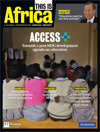Sub-Saharan sovereigns: who to watch in 2013

High commodity prices could help Mozambique, Angola and Gabon on their way to sovereign rating upgrades by 2014, according to Fitch
Some countries in sub-Saharan Africa could be in line for upgrades to their sovereign ratings by 2014, as the region benefits from rising investor interest and growth rates of above 5 percent, according to Fitch Ratings.
Among the agency’s 15 rated sub-Saharan sovereigns, nine have stable outlooks and three positive, with the resource economies of Angola, Mozambique and Gabon eyeing potential upgrades.
“Angola and Mozambique, which both have a positive outlook, will continue to benefit from growth approaching 8 percent, due to improved economic policy and natural resource and infrastructure development,” Fitch said in its 2013 Outlook: Sub-Saharan African Sovereigns report.
Gabon, which is set to grow at 7 percent next year, was placed on positive outlook in April, denoting that an upgrade is more likely than not by 2014.
Gabon, Angola and Mozambique are all major resource producers and are set to benefit from high prices going forward. “In the absence of a major shock to commodity prices, their balance sheets should continue to improve,” Richard Fox, senior director at Fitch explains.
There might be potential for further rating upgrades across the region, but from a low base and at a slow pace, Mr Fox says: “Per capita incomes are still very low and governance remains a key constraint in some countries. These factors change only slowly.”
To win upgrades, Angola, Gabon and Mozambique are faced with the dual challenge of improving physical and social infrastructure, while maintaining prudent fiscal policy. Others are faring less well. Without improvements, Ghana and Uganda could face downward pressure on their stable outlooks, and South Africa – downgraded by Fitch in January – is grappling with acute social and economic challenges.
“Deteriorating potential growth, aggravated by policy uncertainty and indecision in key areas, together with reduced fiscal space have combined to weaken [South Africa’s] credit profile. Failure to address immense social challenges – particularly regarding education and unemployment – will inexorably weigh the rating down,” Fitch explains in its report.
However, as demand for insight on the region’s creditworthiness grows, more countries will come up for ratings. Moody’s, for instance, assigned first time local and foreign currency ratings to Kenya, Nigeria and Zambia this year; while Fitch added Zambia in 2011. “Fitch's portfolio in sub-Saharan Africa has grown from virtually nothing to 15 in a decade. On average we have added one to two new countries every year, at a fairly steady pace,” Mr Fox says.
After Zambia’s successful debut $750m eurobond issuance earlier this year, more rated countries will look to tap international markets for the first time, as they seek to finance their huge infrastructure needs.
“Countries with firm plans to issue include Nigeria and Kenya, and perhaps Rwanda and Ghana too,” Mr Fox observes. “In a low global yield environment, African issuers have all been popular for the attractive yields available and the diversification they provide.”
Currently, 10-year eurobonds from Zambia, Nigeria, Namibia, Ghana and Gabon, are all trading inside 6 percent.
Access+
|
| Access+: A focus on education in Africa This Is Africa takes an in-depth look at the state of education in Africa Visit our Access+ page for: |
|
This is Africa is now on Twitter!
Most Viewed Content
-
5 recommendations
-
2 recommendations
-
1 recommendations
-
1 recommendations
-
1 recommendations




